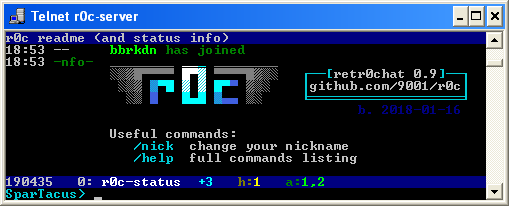mirror of https://github.com/9001/r0c.git
|
|
||
|---|---|---|
| .vscode | ||
| bin | ||
| clients | ||
| docs | ||
| r0c | ||
| scripts | ||
| test | ||
| .editorconfig | ||
| .gitattributes | ||
| .gitignore | ||
| LICENSE | ||
| README.md | ||
| r0c.sublime-project | ||
| setup.py | ||
| start-r0c.bat | ||
| start-r0c.sh | ||
README.md
r0c telnet server
- retr0chat, irc-like chat service for superthin clients (on PyPI)
- MIT-Licensed, 2018-01-07, ed @ irc.rizon.net
- windows telnet 360 noscope <- good video
summary
imagine being stuck on ancient gear, in the middle of nowhere, on a slow connection between machines that are even more archaic than the toaster you're trying to keep from falling apart
retr0chat is the lightweight, no-dependencies, runs-anywhere solution for when life gives you lemons
- tries to be irssi
- zero dependencies on python 2.6, 2.7, 3.x
- supports telnet, netcat, /dev/tcp clients
- fallbacks for inhumane conditions
- linemode
- no vt100 / ansi escape codes
windows clients
- use putty in telnet mode
- or the powershell client
- or enable
Telnet Clientin control panel->programs->programs and features->turn windows features on or off, then press WIN+R and runtelnet r0c.int
putty is the best option;
- windows-telnet has a bug (since win7) where unicode letters become unstable the more text you have on the screen (starts flickering and then disappear one by one)
- the powershell client wastes a LOT of data
(an entire kilobyte for each new message, totally unbelievable, who could possibly afford that)because powershell's scrolling is glitchy af
linux clients
most to least recommended
| client | example |
|---|---|
| telnet | telnet r0c.int |
| socat | socat -,raw,echo=0 tcp:r0c.int:531 |
| bash | mostly internals |
| netcat | nc r0c.int 531 |
you can even exec 147<>/dev/tcp/r0c.int/531;cat<&147&while IFS= read -rn1 x;do [ -z "$x" ]&&x=$'\n';printf %s "$x">&147;done (disconnect using exec 147<&-; killall cat #sorry)
firewall rules
telnet uses port 23 by default, so on the server you'll want to port-forward 23 to 2323 (and 531 to 1531 for plaintext):
iptables -A INPUT -p tcp --dport 23 -m state --state NEW -j ACCEPT
iptables -A INPUT -p tcp --dport 531 -m state --state NEW -j ACCEPT
iptables -A INPUT -p tcp --dport 2323 -m state --state NEW -j ACCEPT
iptables -A INPUT -p tcp --dport 1531 -m state --state NEW -j ACCEPT
iptables -t nat -A PREROUTING -i eth0 -p tcp --dport 23 -j REDIRECT --to-port 2323
iptables -t nat -A PREROUTING -i eth0 -p tcp --dport 531 -j REDIRECT --to-port 1531
documentation
not really but there is a list of commands and a list of hotkeys
